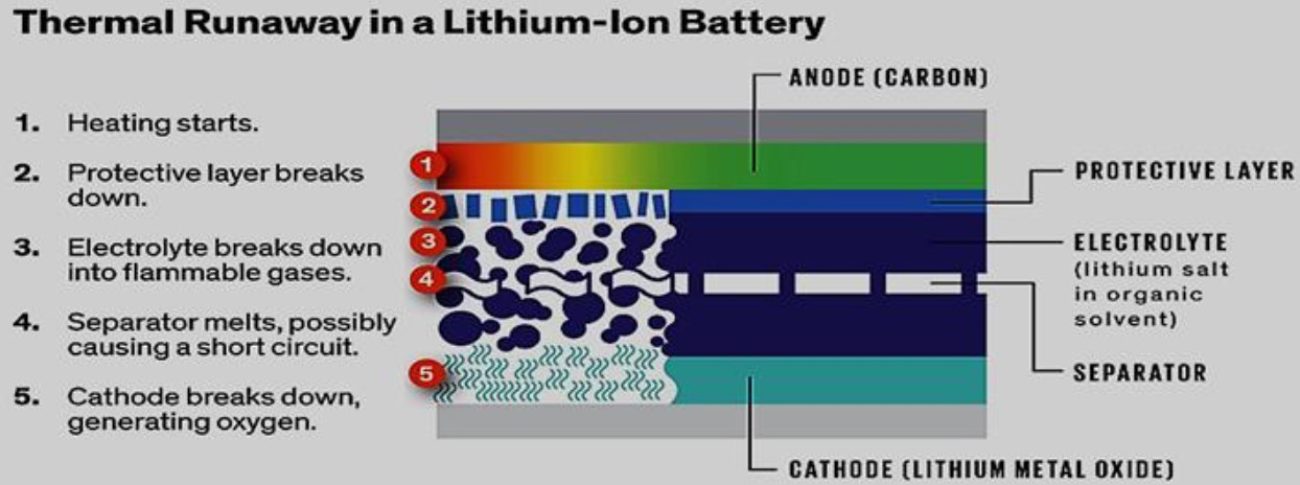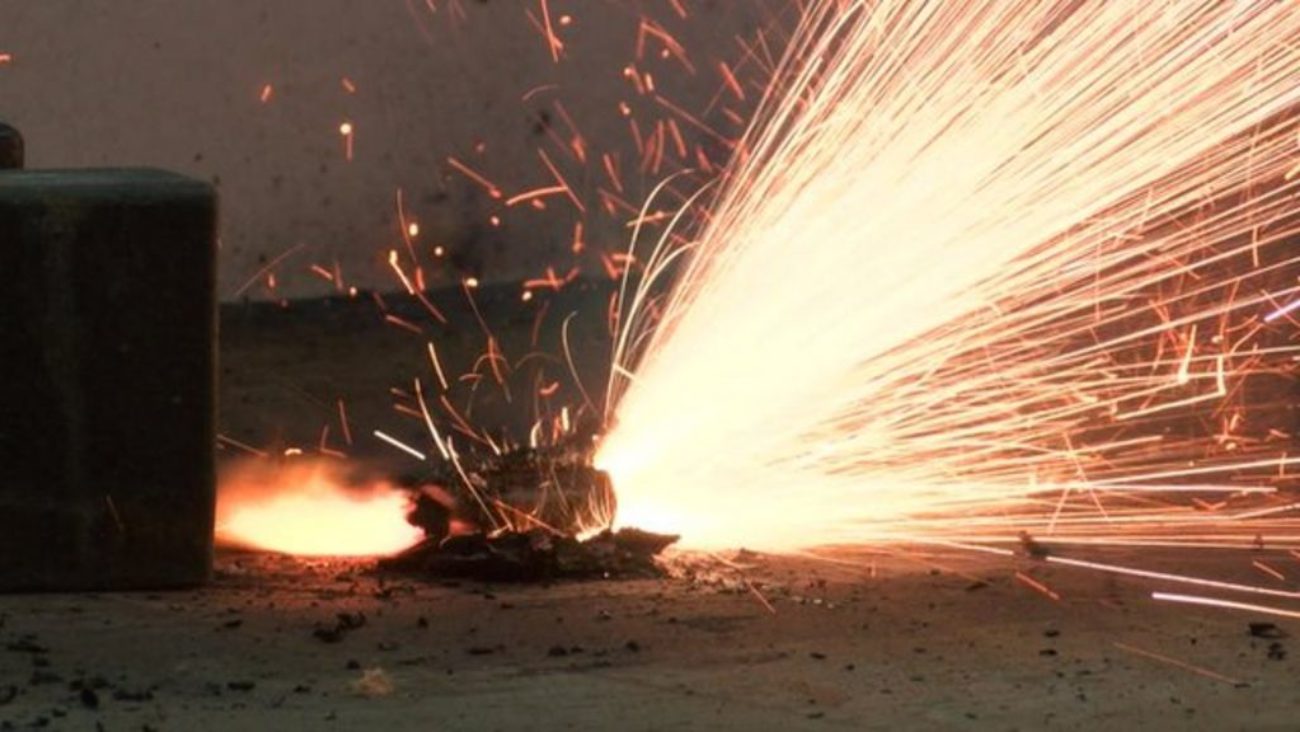The use of Lithium-ion batteries is expanding rapidly in commercial and industrial applications which up until today used more traditional rechargeable batteries.
This innovative technology poses specific potential threats represented by the battery’s thermal “runaway” as a consequence of battery mismanagement / battery abuse and /or defects in battery manufacturing.
The battery runaway may result in serious fires and explosions that may lead to a catastrophe, if the accident is not contained/controlled and the consequent fire is allowed to spread.
Today there are a number of different Lithium-ion battery technologies in the market.
Some technologies are promoted as safer, but experience demonstrated that all the Lithium-ion batteries show the same behaviour/sensitivity versus the adverse effects or battery mismanagement that may lead to a runaway.
Battery thermal runaway.
The battery thermal runaway is a consequence of the battery being subjected to “adverse effects”. It will generate a heavy increase in the battery’s temperature, which will cause the electrolyte gasification and a subsequent rupture of the cells’ metal casing, or in case of lithium-polymers the rupture of the plastic pouch releasing the electrolyte gas.
These vapors, when in contact with the atmosphere, burn (flash fire) at a very high temperature (in excess of 800⁰C). Solarfire Systems also offer a detection system that senses these vapours, you can find our blog post on the off gas system here.
When subject to heating - thermal runaway - the battery cells’ burst suddenly.
The fire will involve in sequence the battery cells and the runaway may last for hours. Experience shows that batteries react for hours after the first incident, even when they are apparently under control.
Through tests performed, it is reported that 120⁰C is the critical temperature since the electrolyte will start to gasify.
The battery shall be cooled down to 40⁰C to interrupt the runaway sequence, however the remaining power stored in the damaged battery poses an additional potential threat.
The electrolyte fire will generate substantial amount of HCl, HF, CO, HCN, and potentially SO2 and H2S, depending on the battery technology and the electrolyte technology.
The release of toxic and/or combustible or explosive substances during a fire can evolve forming an explosive mixture.

Battery electrolyte leakage.
The wrong handling and mismanagement of batteries may result primarily in a battery internal pressure increase, which will lead to the electrolyte leakage.
The pouch/prismatic batteries (wrapping/casing cells made of polymers) are more sensitive to this phenomenon.
The electrolyte leakage poses a potential human hazard in case of exposure/contact, moreover it may cause short circuit of the battery cells and electronics protecting the battery.
Battery anodes and cathodes.
The self-heating of lithium-ion anodes/cathodes, in the presence of electrolyte, initiates at temperatures in the range of 70 to 90°C (158 to 194°F). If a cell is brought to the initiating temperature, it will self-heat to the point where a thermal runaway initiate. For a typical cylindrical metallic body cell, the thermal runaway will occur after approximately two days, if the cell is well-insulated.
The common architecture of Lithium-ion batteries with a cylindrical body is a metallic casing cell. In case of “flat cells”, the cells are wrapped by a “polymer envelop”, defined as a “plastic pouch” battery architecture.
In both cases the “battery” is formed by cell aggregates connected together. The number of “cells” and “cell aggregates” depend on the battery total power to be delivered.
How FirePro works on extinguishing the Lithium Polymers batteries Fires.
The CHEMISTRY is based on the following:
• The most commonly used electrolyte contains lithium hexafluorophosphate salt (LiPF6).
• LiPF6 is highly flammable and undergoes thermal decomposition when the Li-ion cell is exposed to increased temperatures.
• The decomposition of LiPF6 is promoted by the presence of water or humidity, according to the following reactions:
when heated in a dry and inert atmosphere
LiPF6 → LiF(s) + PF5(g)
in the presence of moisture/water, PF5 is further reacted to form POF3 and HF
PF5 + H2O → POF3(g) + 2HF(g)
when heated in normal atmosphere in presence of moisture/water
LiPF6 + H2O → LiF(s) + POF3(g) + 2HF(g)
• During a battery fire and explosion, the gases formed by the thermal breakdown of LiPF6 salt solution are toxic (HF, POF3). High concentrations of HF were detected in fire tests.
The POF3 concentration was below the detection limit.
• Extensive research has been carried out to eliminate the amount of HF or to further neutralize it with alkaline materials.
Fire extinguishers that contain aqueous solutions of metal salts have proven to be effective, through a mechanism where the metal ions bind to the HF gas molecules to form stable solid metal fluorides. [1]
• FirePro condensed aerosol is a promising technology for suppressing Li-ion battery fires, as the main components of the fire extinguishing aerosol are alkaline potassium salts.
Both the active agent K2CO3 and KOH intermediate product can react with HF to form stable products, according to the following reactions:
K2CO3 + 4HF → 2KHF2(s) + CO2 + H2O
KOH + HF → KF(s) + H2O
As a result, this neutralization allows the room temperature to lessen significantly below 120°C, the threshold temperature below which the thermal reaction within a Li-on battery will stop.
Post discharge the condensed aerosol Active Agent remains in the atmosphere of the enclosure for at least 30 minutes preventing any re-ignition. This is due to the characteristics of the potassium salts that can chemically neutralize and provide stability to the atmosphere.
[1] Patent No.: US20120312562A1, Method for fighting and/or preventing fires in lithium ion cells and lithium ion polymer cell.
Fire Protection Systems from SolarFire Systems
Whether you need a new Condensed Aerosol Fire Suppression System, Fire Alarm system or a Hypoxic Fire Prevention system installed at your commercial property, SolarFire Systems has you covered with many types of automatic fire extinguishing systems. We are known for our excellent customer service, our expertise, and our reliability.
Call us on 01628 902107 or email [email protected]
